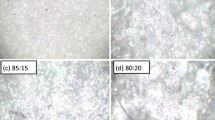Abstract
The ionic conductivity of poly(ethylene oxide) and poly(propylene oxide) in pure solution form, individually complexed with salts of Na+ and Li+, with and without plasticizer (propylene carbonate) and in blended form with individual salt with and without plasticizer, was studied. The conductance measurements were made at various concentrations of salt polymer complexes and at different temperatures. The effects of temperature and plasticizer concentration were measured from Arrhenius conductance plots. It is shown that the addition of salts in pure PEO increases conductance many times. The plasticizer has also same effect. The blending of PEO with PPO gives enhanced conductivity as compared to pure PEO. The activation energies were determined for all the systems which gave higher values for pure PEO and the value decreases with the addition of Li and Na salts and further decreases with the addition of plasticizer. The blending has also lowered the activation energy values which mean that incorporation of PPO in PEO has decreased crystallinity and the amorphous region has increased the local mobility of polymer chains resulting in lower activation energies.




Similar content being viewed by others
References
Armand MB, Chabango JM (1997) In: Vashista P, Mundy JN, Shen JK (eds) Fast ion transport in solids. Elsevier, North Holland, p 131
Hooper A, Gauthier M, Belanger A (1990) In: Linford RG (ed) Electrochemical science and technology of polymers, vol. 2. Elsevier, London, p 375
Scrosati B (1993) Applications of electro active polymers. Chapman and Hall, London
Gray FM (1997) Solid polymer electrolytes, RSC Materials Monographs, RSC, Cambridge
Kelly IE, Owen JR, Steele BCH (1985) Poly (ethylene oxide) electrolytes for operation at near room temperature. J Power Sources 14(1–3):13–21
Wang C, Liu Q, Cao Q, Meng Q, Wang LY, Liu C, Cau Q, Yang I (1992) Investigation on the structure and the conductivity of plasticized polymer electrolytes. Solid State Ionics 53:1106–1110
Song JY, Wang YY, Wan CC (1999) Review of gel-type polymer electrolytes for lithium-ion batteries. J Power Sources 77:183–197
Tarascon JM, Armand M (2001) Issues and challenges facing rechargeable lithium batteries. Nature 414:359–367
Marques FMB, Navarro LM (1996) Performance of double layer electrolyte cells Part I: Model behavior. Solid State Ionics 86:183–19
Yang H, Farrigton GC (1989) In: Scrosati B (ed) In 2nd international symposium on polymer electrolytes. Elsevier, New York, p 265
Chandrasekaran R, Selladurai S (2001) Preparation and characterization of a new polymer electrolyte (PEO:NaClO3) for battery application. J Solid State Electrochem 5:355–361
Croce F, Persi L, Scrosati B, Serraino-Fiory F, Plichta E, Hendrickson MA (2001) Role of the ceramic fillers in enhancing the transport properties of composite polymer electrolytes. Electrochem Acta 46(16):2457–2461
Croce F, Appetecchi GB, Persi L, Scrosati B (1998) Nanocomposite polymer electrolytes for lithium batteries. Nature 394:456–458
Appetecchi GB, Hassoun J, Scrosati B, Croce F, Cassel F, Salomon M (2003) Hot-pressed, solvent-free, nanocomposite, PEO-based electrolyte membranes: II. All solid-state Li/LiFePO4 polymer batteries. J Power Sources 124:246–253
Plancha M JC, Rangel CM, Sequeira CAC (1999) Pseudo-equilibrium phase diagrams of PEO-Zn salts-based electrolytes. Solid State Ionics 116:293–300
Author information
Authors and Affiliations
Corresponding author
Rights and permissions
About this article
Cite this article
Khan, M.S., Shakoor, A. & Nisar, J. Conductance study of poly(ethylene oxide)- and poly(propylene oxide)-based polyelectrolytes. Ionics 16, 539–542 (2010). https://doi.org/10.1007/s11581-010-0424-3
Received:
Revised:
Accepted:
Published:
Issue Date:
DOI: https://doi.org/10.1007/s11581-010-0424-3




